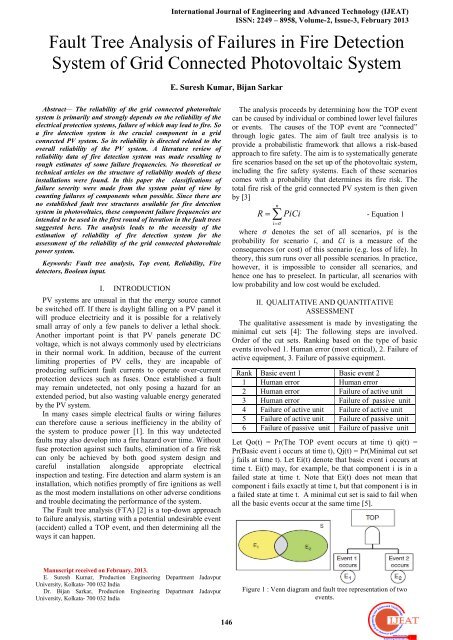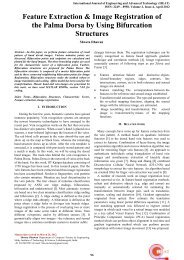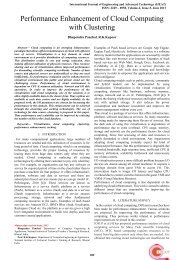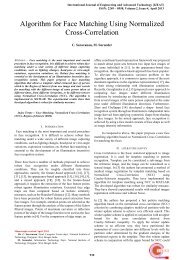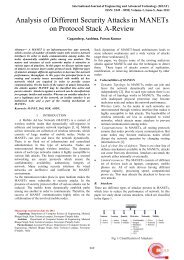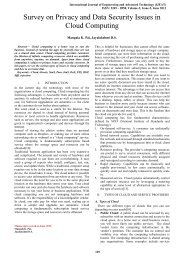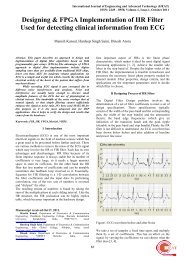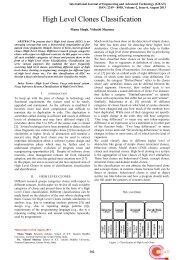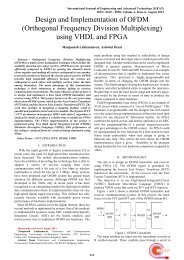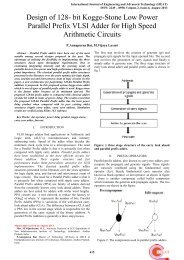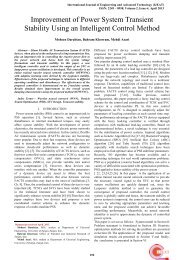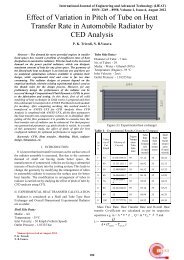Fault Tree Analysis of Failures in Fire Detection System of Grid ...
Fault Tree Analysis of Failures in Fire Detection System of Grid ...
Fault Tree Analysis of Failures in Fire Detection System of Grid ...
You also want an ePaper? Increase the reach of your titles
YUMPU automatically turns print PDFs into web optimized ePapers that Google loves.
<strong>Fault</strong> <strong>Tree</strong> <strong>Analysis</strong> <strong>of</strong> <strong>Failures</strong> <strong>in</strong> <strong>Fire</strong> <strong>Detection</strong> <strong>System</strong> <strong>of</strong> <strong>Grid</strong> Connected Photovoltaic <strong>System</strong>Let Ei(t) denote that event Ei occurs at time t, and let qi(t) =Pr(Ei(t)) for i = 1, 2. When the basic events are <strong>in</strong>dependent,the TOP event probability Q0(t) is Q0(t) = Pr(E1(t) \ E2(t))= Pr(E1(t)) · Pr(E2(t)) = q1(t) · q2(t). When we have a s<strong>in</strong>gleAND-gate with m basic events, we getA m<strong>in</strong>imal cut set fails if and only if all the basic events <strong>in</strong>the set fail at the same time. The probability that cut set jfails at time t iswhere it is assumed that all the r basic events <strong>in</strong> them<strong>in</strong>imal cut set j are <strong>in</strong>dependent.T = C1 + C2 + ........ +C Nc - Equation 3Qsys= P(T) = P( C1 +C2 +.. + C Nc ) - Equation 4Basic structure <strong>of</strong> fire detection and alarm systems is given<strong>in</strong> Figures 1 to 3. The ma<strong>in</strong> components <strong>of</strong> the system arecontrol unit, <strong>in</strong>itiat<strong>in</strong>g devices, manual fire alarm boxes,notification appliances, ma<strong>in</strong> and standby power supplies,wir<strong>in</strong>g <strong>of</strong> the alarm circuits, signall<strong>in</strong>g l<strong>in</strong>e to municipalcentral station, and <strong>in</strong>stallation layout charts (Wilson 1997).The oldest systems, where alarm is caused by open<strong>in</strong>g orshunt<strong>in</strong>g a alarm circuit, are not shown, because they are nomore <strong>in</strong>stalled. In more modern <strong>in</strong>stallations one or severalalarm <strong>in</strong>itiat<strong>in</strong>g device circuits are connected to a controlunit. One circuit covers a certa<strong>in</strong> part <strong>of</strong> a build<strong>in</strong>g, onwhich all <strong>in</strong>itiat<strong>in</strong>g devices <strong>in</strong> that area are connected. Inlocal-energy type alarm system <strong>in</strong>itiat<strong>in</strong>g devices aregalvanically connected to a two-wire circuit,Figure 1: Pr<strong>in</strong>cipal structure and components <strong>of</strong> a stub l<strong>in</strong>e.Figure 2 : M<strong>in</strong>imal cut set representation from basic events.Figure 2: Pr<strong>in</strong>cipal structure and components <strong>of</strong> a loop l<strong>in</strong>efire detection and alarm system with a stub l<strong>in</strong>e sub circuit.Which has an end-<strong>of</strong> -l<strong>in</strong>e resistor. The circuit operates onnon-energized pr<strong>in</strong>ciple. Trigger<strong>in</strong>g <strong>of</strong> an <strong>in</strong>itiat<strong>in</strong>g devicemechanically or electrically shunts this l<strong>in</strong>e caus<strong>in</strong>g analarm.Figure 3 : M<strong>in</strong>imal cut set failure to TOP event failure.The TOP event occurs if at least one <strong>of</strong> the m<strong>in</strong>imal cutsets fails. The TOP event probability is [6]- Equation 2The reason for the <strong>in</strong>equality sign is that the m<strong>in</strong>imal cutsets are not always <strong>in</strong>dependent. The same basic event maybe member <strong>of</strong> several cut sets. Equation 2 is called theUpper Bound Approximation.Us<strong>in</strong>g fault tree analysis predictions for the failureprobability or the failure frequency <strong>of</strong> the system (top event)can be made [7]. Here the top event probability isconsidered. Hav<strong>in</strong>g obta<strong>in</strong>ed the m<strong>in</strong>imal cut sets the topevent logic equation can be expressed as the disjunction(OR) <strong>of</strong> the NC m<strong>in</strong>imal cut sets, Ci. The system failureprobability, Qsys, is then the probability <strong>of</strong> this disjunction:Figure 3: Pr<strong>in</strong>cipal structure <strong>of</strong> a fire detection and alarm<strong>in</strong>gsystem with alarm transmission, notification devices andcontrol signals to auxiliary fire protection systems.In systems with signall<strong>in</strong>g l<strong>in</strong>e circuits <strong>in</strong>itiat<strong>in</strong>g devices areaddressable and two-way communication takes place.Control panel electronics polls out periodically at a properfrequency the status <strong>of</strong> the device: operation, service,trouble, fire. Although the devices may be connectedphysically to the same electrical circuit, they can beprogrammed <strong>in</strong>to arbitrary configurations <strong>of</strong> groups.Installation layout charts are floor plan draw<strong>in</strong>gs <strong>of</strong> thebuild<strong>in</strong>g <strong>in</strong>dicat<strong>in</strong>g the location <strong>of</strong> alarm control panel,access routes, and locations <strong>of</strong> alarm<strong>in</strong>g devices or circuits.These layout charts make possible quick location <strong>of</strong> fire <strong>in</strong>the build<strong>in</strong>g. <strong>Fire</strong> alarm system control unit/panel notifies147
International Journal <strong>of</strong> Eng<strong>in</strong>eer<strong>in</strong>g and Advanced Technology (IJEAT)ISSN: 2249 – 8958, Volume-2, Issue-3, February 2013voltage or circuit current, (5.2) failures <strong>in</strong> standby powerbatteries, and (5.3) faulty component/connection.The Boolean <strong>in</strong>puts represent the follow<strong>in</strong>g events. A5 : 5.1<strong>Failures</strong> <strong>in</strong> ma<strong>in</strong>s voltage or circuit current, B5 : 5.2 <strong>Failures</strong><strong>in</strong> standby batteries, C5 : 5.3 <strong>Fault</strong>y component/connection.The Boolean <strong>in</strong>puts <strong>in</strong> figure 12 represent the follow<strong>in</strong>gevents. A6 : 6.1.1 Communication error, B6 : 6.1.2 Controlerror, C6 : 6.1.3 Test<strong>in</strong>g Error, D6 : 6.2.1 Insufficient/faultyguidance, E6 : 6.2.2 Design error, modification.Figure 9 : <strong>Fault</strong> tree <strong>of</strong> failures <strong>in</strong> signal communicationsubsystem.fire dampers, (4.3) ext<strong>in</strong>guish<strong>in</strong>g systems, (4.4) pumps, and(4.5) alarm<strong>in</strong>g/notification appliances.The Boolean <strong>in</strong>puts <strong>in</strong> figure 9 represent the follow<strong>in</strong>gevents. A4 : Failure <strong>in</strong> computer/ cod<strong>in</strong>g, B4 : Control <strong>of</strong>fire dampers, C4 : Control <strong>in</strong> ext<strong>in</strong>guish<strong>in</strong>g systems, D4 :Control <strong>of</strong> fire pumps, E4 : Control <strong>of</strong> alarm<strong>in</strong>g/ notificationappliances.<strong>Failures</strong> <strong>in</strong> power supply are divided <strong>in</strong>to three subgroups <strong>in</strong>Figure 11: (5.1) failures <strong>in</strong> ma<strong>in</strong>sFigure 12 : <strong>Fault</strong> tree by cause <strong>of</strong> failures result<strong>in</strong>g <strong>in</strong> falsealarms.<strong>Failures</strong> result<strong>in</strong>g <strong>in</strong> false alarms are collected <strong>in</strong> Figure 12<strong>in</strong> two subunits: (6.1) human error, and (6.2) <strong>in</strong>structionerror. Human errors consist <strong>of</strong> (6.1.1) communication,(6.1.2) control and (6.1.3) test<strong>in</strong>g errors, whereas <strong>in</strong>structionerrors are divided <strong>in</strong>to (6.2.1) <strong>in</strong>sufficient/faultyguidance/data, and (6.2.2) design error or modification.Figure 10 : <strong>Fault</strong> tree <strong>of</strong> failures <strong>in</strong> auxiliary controlsubsystems.Figure 11 : <strong>Fault</strong> tree <strong>of</strong> power supply failure.IV. CONCLUSION AND FUTURE SCOPEThe reliability <strong>of</strong> the grid connected photovoltaic system isprimarily and strongly depends on the reliability <strong>of</strong> theelectrical protection systems, failure <strong>of</strong> which may lead t<strong>of</strong>ire. So a fire detection system is the crucial component <strong>in</strong> agrid connected PV system. So its reliability is directedrelated to the overall reliability <strong>of</strong> the PV system. Theclassifications <strong>of</strong> failure severity were made from the systempo<strong>in</strong>t <strong>of</strong> view by count<strong>in</strong>g failures <strong>of</strong> components whenpossible. S<strong>in</strong>ce there are no established fault tree structuresavailable for fire detection system <strong>in</strong> photovoltaics, thesecomponent failure frequencies are <strong>in</strong>tended to be used <strong>in</strong> thefirst round <strong>of</strong> iteration <strong>in</strong> the fault trees suggested here. It ispossible, that analyses to be carried out later, might requireconsiderable changes to these proposals either due tolack<strong>in</strong>g statistical <strong>in</strong>formation from some proposed boxes, ordue to <strong>in</strong>ternal structure <strong>of</strong> the system presumed too simple<strong>in</strong> this paper. Before these analyses become feasible, thepo<strong>in</strong>t estimates <strong>of</strong> failure frequencies <strong>of</strong> the ma<strong>in</strong>components/subsystems are needed with error ranges forevaluat<strong>in</strong>g the relevance <strong>of</strong> observations. The study gave adetailed account on fault tree modell<strong>in</strong>g, but not yetsufficiently close the effort <strong>in</strong> the form <strong>of</strong> failure frequenciesand fault trees, which are left to later studies <strong>of</strong> the problem.150
<strong>Fault</strong> <strong>Tree</strong> <strong>Analysis</strong> <strong>of</strong> <strong>Failures</strong> <strong>in</strong> <strong>Fire</strong> <strong>Detection</strong> <strong>System</strong> <strong>of</strong> <strong>Grid</strong> Connected Photovoltaic <strong>System</strong>REFERENCES[1] Paul K. Kuhn, Cynthia Furse, Paul Smith, (2006) - Locat<strong>in</strong>g HiddenHazards <strong>in</strong> Electrical Wir<strong>in</strong>g, Symposium on Aged Electrical <strong>System</strong>sResearch Application October 18-19, 2006, Chicago, Ill<strong>in</strong>ois, USA.[2] Mohammad Sadegh Javadi1, Azim Nobakht2, Ali Meskarbashee(2011) - <strong>Fault</strong> <strong>Tree</strong> <strong>Analysis</strong> Approach <strong>in</strong> Reliability Assessment <strong>of</strong>Power <strong>System</strong>, International journal <strong>of</strong> multidiscipl<strong>in</strong>ary sciences andeng<strong>in</strong>eer<strong>in</strong>g, vol. 2, no. 6, september 2011.[3] Casey C. Grant, P.E. (2010) - <strong>Fire</strong> Fighter Safety and EmergencyResponse for Solar Power <strong>System</strong>s, The <strong>Fire</strong> Protection ResearchFoundation, © Copyright <strong>Fire</strong> Protection Research Foundation, May2010.[4] Wang Cheng-gang, Wang Zi-zhen (2010) - Design andImplementation <strong>of</strong> Safety Expert Information Management <strong>System</strong> <strong>of</strong>Coal M<strong>in</strong>e Based on <strong>Fault</strong> <strong>Tree</strong> , Journal <strong>of</strong> S<strong>of</strong>tware, Volume 5, NO.10, October 2010, Pages : 1114 -1120.[5] R. Karimi, N. Rasmussen and L. Wolf (May 1980 ) – Qualitative andquantitative reliability analysis <strong>of</strong> safety systems, Energy LaboratoryReport No. MIT-EL 80-015, Energy Laboratory and Department <strong>of</strong>Nuclear Eng<strong>in</strong>eer<strong>in</strong>g Massachusetts Institute <strong>of</strong> TechnologyCambridge, Massachusetts 02139.\[6] Sanjay Kumar Tyagi, D. Pandey and Reena Tyagi (2010) -Fuzzy settheoretic approach to fault tree analysis, International Journal <strong>of</strong>Eng<strong>in</strong>eer<strong>in</strong>g, Science and Technology Vol. 2, No. 5, 2010, pp. 276-283.[7] John Andrews (2012) - Introduction to <strong>Fault</strong> <strong>Tree</strong> <strong>Analysis</strong>, 2012Annual RELIABILITY and MAINTAINABILITY Symposium.[8] Lei Zhang, and Ga<strong>of</strong>eng Wang (2009) - Design and Implementation<strong>of</strong> Automatic <strong>Fire</strong> Alarm <strong>System</strong> based on Wireless Sensor Networks,ISBN 978-952-5726-02-2 (Pr<strong>in</strong>t), 978-952-5726-03-9 (CD-ROM)Proceed<strong>in</strong>gs <strong>of</strong> the 2009 International Symposium on InformationProcess<strong>in</strong>g (ISIP’09) Huangshan, P. R. Ch<strong>in</strong>a, August 21-23, 2009,pp. 410-413.[9] Merton Bunker ( 2007) - <strong>Fire</strong> Alarm <strong>System</strong>s Gett<strong>in</strong>g It Right TheFirst Time, IMSA Journal Pages : 32-49.[10] Marsh (2008) - Effectiveness <strong>of</strong> <strong>Fire</strong> Safety <strong>System</strong>s for Use <strong>in</strong>Quantitative Risk Assessments, New Zealand <strong>Fire</strong> ServiceCommission Research Report Number 89, ISBN Number 978-1-877349-83-6 (on-l<strong>in</strong>e), ISBN Number 978-1-877349-82-9(paperback) © Copyright New Zealand <strong>Fire</strong> Service Commission.E Suresh Kumar is a Research Scholar at JadavpurUniversity Kolkata and an Assistant Pr<strong>of</strong>essor atCollege <strong>of</strong> Eng<strong>in</strong>eer<strong>in</strong>g, Trivandrum, India. His field <strong>of</strong><strong>in</strong>terest <strong>in</strong>cludes microelectronics, quality andreliability, renewable energy and photovoltaics.Dr. Bijan Sarkar is a Pr<strong>of</strong>essor and the former Head <strong>of</strong>the Department <strong>of</strong> Production Eng<strong>in</strong>eer<strong>in</strong>g at theJadvapur University, Kolkata. He is a specialist <strong>in</strong>reliability, terotechnology, tribology and operationsmanagement. He supervised many M.Tech and Ph.Dthesis and published papers <strong>in</strong> many <strong>in</strong>ternationallyreputed journals.151


